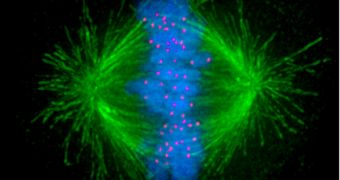A team of scientists at the Carnegie Institution for Science (CIS) has just completed a new study on a critically-important stage in the cell division process, the moment when two daughter cells are formed, each boasting an equal complement of chromosomes.
Cell division is a well-known process that is taught in middle schools. Known as mitosis, this process sees a fully-grown adult cell separate into two identical cells of the same type. In this regard, mitosis is absolutely essential for the continuation of life on our planet.
The entire process is, however, carried out in a number of steps and stages, and some of these intermediary stepping stones are not that well understood. For this study, CIS experts led by scientist Yixian Zheng focused on the separation phase that occurs when a cell divides.
The reason why this process is so important for doctors is that the errors which may occur at this time can have very severe implications on human health. For example, losing or gaining chromosomes during abnormal cell division can lead to conditions such as cancer.
Therefore, understanding mitosis can prove to be an easy way to find new therapeutic targets against a wide variety of diseases that are currently very difficult to treat. Zheng focused her team's efforts on understanding how an equal complement of chromosomes is transmitted between cell generations.
Details of the study appear in a paper published in the latest issue of the esteemed journal Developmental Cell. The team provides an in-depth analysis of a kinetochore, which is a group of more than 90 proteins that interact with microtubules.
The latter are fibers arranged in a scaffold-like structure, which play an important role in pulling the opposite ends of a cell apart during division. They provide the mechanical force for separating the two parts of the cell into two fully-functioning offspring.
The researchers explain that the kinetochore and microtubules work together to provide the scaffolding and forces needed for the correct passing of the right number of chromosomes from the progenitor cells to its descendants.
Zheng and her team were also able to find a protein that appears to play a role in regulating exactly how kinetochores and microtubules interact.
“Our work demonstrates the importance of expanding the scope of study to include other cellular components because this is critical to achieving an in depth understanding of the mechanisms underlying chromosome alignment in preparation for dividing the DNA into two new cells,” the expert concludes.

 14 DAY TRIAL //
14 DAY TRIAL //